|
|
Charter of the United Nations
San Francisco, 26 June 1945
- Introductory Note
- Procedural History
- Documents
- Status
- Video
- Photo
F o r t h c o m i n g
Introductory note to be published
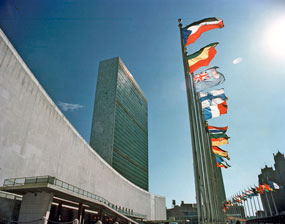 The United Nations Charter is the constituting instrument of the Organization, setting out the rights and obligations of Member States, and establishing the United Nations organs and procedures. An international treaty, the Charter codifies the major principles of international relations, from sovereign equality of States to the prohibition of the use of force in international relations. The United Nations Charter is the constituting instrument of the Organization, setting out the rights and obligations of Member States, and establishing the United Nations organs and procedures. An international treaty, the Charter codifies the major principles of international relations, from sovereign equality of States to the prohibition of the use of force in international relations.
The Charter opens with a Preamble, and includes chapters on United Nations Purposes and Principles, Membership, Organs, Pacific Settlement of Disputes, Action with Respect to Threats to the Peace, Breaches of the Peace and Acts of Aggression, International Economic Cooperation, and Non-Self-Governing Territories.
[Basic Facts about the United Nations, United Nations Publication (Sales No. E.98.I.20), p.3.]
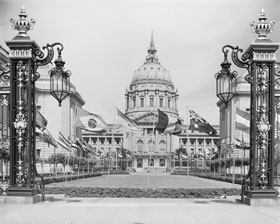 The origin of the Charter of the United Nations can be traced back to the Atlantic Charter, signed on 14 August 1941, by which Franklin D. Roosevelt, President of the United States of America, and Winston Churchill, Prime Minister of the United Kingdom, made known “certain common principles in the national policies of their respective countries on which they base their hopes for a better future for the world”. This document, in its eighth paragraph, incidentally referred to the future “establishment of a wider and permanent system of general security”. The origin of the Charter of the United Nations can be traced back to the Atlantic Charter, signed on 14 August 1941, by which Franklin D. Roosevelt, President of the United States of America, and Winston Churchill, Prime Minister of the United Kingdom, made known “certain common principles in the national policies of their respective countries on which they base their hopes for a better future for the world”. This document, in its eighth paragraph, incidentally referred to the future “establishment of a wider and permanent system of general security”.
On 1 January 1942, 26 States at war with the Axis Powers, including the United States, the United Kingdom, China and the Union of Soviet Socialist Republics (USSR), subscribed to the common programme of purposes and principles embodied in the Atlantic Charter in a document, which became known as the “Declaration by United Nations”, containing the first official use of the term “United Nations” (21 other States adhered to that Declaration at a later date).
From 18 October to 1 November 1943, a Conference was held in Moscow, with the participation of the United States, the United Kingdom, the USSR and China. At the conclusion of the Conference, the participating Governments adopted a Joint Four-Nation Declaration in which, inter alia, they “recognize[d] the necessity of establishing at the earliest practicable date a general international organization, based on the principle of the sovereign equality of all peace-loving States, and open to membership by all such States, large and small, for the maintenance of international peace and security”. For the first time, the idea of establishing an international organization to keep the peace after the end of World War II was thus expressly mentioned in an official document. Following this Declaration, the four States concerned appointed national committees of experts that separately worked on the drafting of a charter for the future organization (there were, however, earlier efforts in this direction in the United States, with the work of the Advisory Committee on Problems of Foreign Relations established on 27 December 1939, which was officially pursued by the State Department from 1942 until the Conference of Dumbarton Oaks, in 1944).
From 28 November to 1 December 1943, President Roosevelt, Prime Minister Churchill and the Premier of the USSR, Joseph Stalin, met at a conference in Tehran, where they again confirmed their common policy, notably expressing their determination that their nations “shall work together in war and in the peace that will follow”, recognizing “the supreme responsibility resting upon us and all the United Nations to make a peace which will command the goodwill of the overwhelming mass of the peoples of the world and banish the scourge and terror of war for many generations”. They further announced their intention to “seek the cooperation and active participation of all nations, large and small, whose peoples in heart and mind are dedicated, as are our own peoples, to the elimination of tyranny and slavery, oppression and intolerance” within a “world family of Democratic Nations” (Declaration of the Three Powers, Tehran, 1 December 1943).
From 21 August to 7 October 1944, representatives of the United States and the United Kingdom met separately with representatives of the USSR (21 August-28 September) and of China (29 September-7 October), at Dumbarton Oaks in the context of the “Washington Conversations on International Peace and Security Organization” (or Dumbarton Oaks Conference). The reports prepared at the national level by each Government following the Moscow Conference were exchanged at the Conference. A steering committee was entrusted with reaching agreement on the main substantive issues and a Joint Formulation Group drafted a text resulting from such negotiations in the form of a treaty. The final document prepared at the Conference, issued on 9 October 1944, became known as the “Proposals for the Establishment of a General International Organization”, which constituted the initial working document at the San Francisco Conference, in 1945.
Negotiations on the future international organization continued at the Yalta Conference, attended by President Roosevelt, Prime Minister Churchill and Premier Stalin, from 4 to 11 February 1945. The Protocol of Proceedings of this Conference included a section devoted to the “World Organization”, which contained, inter alia, the decision of summoning a “United Nations conference on the proposed world organization” in the United States on 25 April 1945. This document specified the nations to be invited to the conference, as well as the text of the invitation to be issued.
Further support to the Dumbarton Oaks Proposals was expressed at the Conference of the American Republics, held at Mexico City from 2 February to 8 March 1945.
The United Nations Conference on International Organization was convened in San Francisco from 25 April to 26 June 1945. Fifty States participated in the Conference, at the invitation of the Governments of the United States, the United Kingdom, the USSR and China. The work of the San Francisco Conference was organized as follows. The highest body was the Conference in Plenary Session, which was in charge of the final voting and adoption of the text. Below the plenary, four committees were established:
| - |
the Steering Committee, composed of the chairmen of all delegations, which considered major questions of policy and procedure; |
| - |
the Executive Committee, composed of the chairmen of 14 delegations (those of the four sponsoring Governments and ten co-elected members), serving the Steering Committee by preparing recommendations for its consideration; |
| - |
the Coordination Committee, composed of technical members of the same 14 delegations, which assisted the Executive Committee and was itself assisted by an Advisory Committee of Jurists; and |
| - |
the Credentials Committee, formed by representatives from six delegations, verifying the credentials of delegates. |
Below this level, the study of the most important issues to be settled was divided among four general commissions, which coordinated the work of twelve technical committees, charged with the preparation of drafting proposals; when needed, the technical committees could designate sub-committees. The work was organized as follows:
| - |
Commission I (General Provisions) coordinated the work of Technical Committee 1 (Preamble, Purposes and Principles) and Technical Committee 2 (Membership, Amendment and Secretariat); |
| - |
Commission II (General Assembly) coordinated the work of Technical Committee 1 (Structure and Procedures), Technical Committee 2 (Political and Security Functions), Technical Committee 3 (Economic and Social Cooperation) and Technical Committee 4 (Trusteeship System); |
| - |
Commission III (Security Council), coordinated the work of Technical Committee 1 (Structure and Procedures), Technical Committee 2 (Peaceful Settlement), Technical Committee 3 (Enforcement Arrangements) and Technical Committee 4 (Regional Arrangements); and |
| - |
Commission IV (Judicial Organization), coordinated the work of Technical Committee 1 (International Court of Justice) and Technical Committee 2 (Legal Problems). |
A Secretariat provided general administration to the Conference. On the side of this official structure, informal consultations were held among delegations, most notably among the five principal powers at the Conference (the United States, the United Kingdom, the USSR, China and France). More than five thousand documents were considered at the Conference: a compilation of the principal documents was published under the title Documents of the United Nations Conference on International Organization, San Francisco, Volumes I to XX, 1945-1954.
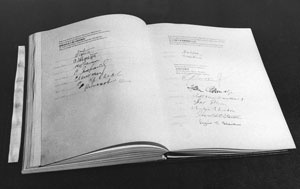 The Charter of the United Nations, together with the Statute of the International Court of Justice which forms an integral part of the Charter, was adopted unanimously at the end of the Conference, on 25 June 1945 at the San Francisco Opera House, and was signed the following day at the Herbst Theatre auditorium of the Veterans War Memorial Building. It entered into force, in accordance with its Article 110, paragraph 3, on 24 October 1945, following the deposit of the instruments of ratification of the five permanent members of the Security Council and a majority of all other signatories. The Charter of the United Nations, together with the Statute of the International Court of Justice which forms an integral part of the Charter, was adopted unanimously at the end of the Conference, on 25 June 1945 at the San Francisco Opera House, and was signed the following day at the Herbst Theatre auditorium of the Veterans War Memorial Building. It entered into force, in accordance with its Article 110, paragraph 3, on 24 October 1945, following the deposit of the instruments of ratification of the five permanent members of the Security Council and a majority of all other signatories.
The Charter of the United Nations has been amended three times since its entry into force, in accordance with the procedure provided for under Article 108 (adoption by a vote of two-thirds of the members of the General Assembly and ratification by two-thirds of the Members of the United Nations, including all the permanent members of the Security Council). On 17 December 1963, the General Assembly adopted, by a vote of 96 to 11, with 4 abstentions, amendments to Articles 23 and 27 (expanding the number of elected members of the Security Council from 6 to 10 and modifying the voting majorities accordingly) and to Article 61 (expanding the membership of the Economic and Social Council from 18 to 27 members); this amendment entered into force on 31 August 1965. On 20 December 1965, the General Assembly unanimously adopted a further amendment to Article 109 (modifying the majority required in the Security Council for the convening of a review conference, as a consequence of the previous amendment to Articles 23 and 27); this amendment entered into force on 12 June 1968. On 20 December 1973, the General Assembly adopted, by a vote of 105 to 2, with 15 abstentions, a further amendment to Article 61 (bringing the number of members of the Economic and Social Council to 54); this amendment entered into force on 24 September 1973.
Selected preparatory documents
(in chronological order)
Atlantic Charter, 14 August 1941
Declaration by United Nations (Joint Declaration by the United States, the United Kingdom, the Union of Soviet Socialist Republics, China, Australia, Belgium, Canada, Costa Rica, Cuba, Czechoslovakia, Dominican Republic, El Salvador, Greece, Guatemala, Haiti, Honduras, India, Luxembourg, Netherlands, New Zealand, Nicaragua, Norway, Panama, Poland, South Africa and Yugoslavia), 1 January 1942
Joint Four-Nation Declaration (the United States, the United Kingdom, the USSR and China), 1 November 1943
Declaration of the Three Powers, Tehran, 1 December 1943
Proposals for the Establishment of a General International Organization, 9 October 1944
Protocol of Proceedings of the Crimea Conference, Yalta, 11 February 1945
Documents of the United Nations Conference on International Organization, San Francisco, Volumes I to XX, 1945-1954
The Charter entered into force on 24 October 1945. For the current participation status of the Charter, as well as information and relevant texts of related treaty actions, such as reservations, declarations, objections, denunciations and notifications, see:
The Status of Multilateral Treaties Deposited with the Secretary-General
| Statements |
San Francisco Conference, San Francisco, 26 June 1945 (Edited film “San Francisco Conference”, produced by US Information Agency)
Video (11 minutes, Full Version) |
 |
Documentary on the San Francisco Conference, 25 April to 26 June 1945
Video (4 minutes, Full Version) |
 |
 |
Lord Halifax, President of the Ninth Session of the Conference, puts to the vote the Charter of the United Nations and the Statute of the International Court of Justice, which are both adopted, 25 June 1945
Video (1 minute, English) |
 |
Statement by Mr. Harry Truman, President of the United States of America, on the Closing Plenary Session of the Conference, 26 June 1945
Video (31 seconds, English) |
United Nations Preparatory Commission, first Plenary Meetings, Church House, London, 26 November and 23 December 1945
Video (13 minutes, Full Version) |
 |
 |
Opening of the First Plenary Meeting by Temporary President P. J. Noel-Baker (UK), 26 November 1945
Video (1 minute, English) |
 |
Statement by P.H. Spaak (Belgium) at the First Plenary Meeting, 26 November 1945
Video (1 minute, Français) |
 |
Adoption of the Agenda by Temporary President P.J. Noel-Baker (UK) and announcement of the nomination of H.E. Eduardo Zuleta Angel (Colombia) as President, Second Plenary Meeting, 26 November 1945
Video (1 minute, English) |
 |
Statement by President H.E. Eduardo Zuleta Angel (Colombia) after his election at the Second Plenary Meeting, 26 November 1945
Video (1 minute, Français) |
 |
Closing statement by President H.E. Eduardo Zuleta Angel (Colombia) at the Fourth Plenary Meeting, 23 December 1945
Video (32 seconds, Français) |
 |
Statement by P.J. Noel-Baker (UK), Fourth Plenary Meeting
Video (1 minute, English) |
 |
Statement by Mr. W. Koo (China), Fourth Plenary Meeting
Video (1 minute, English) |
First Session of the General Assembly, Opening of the First Plenary Meeting, Central Hall, London, 10 January 1946
[Minor sound quality problem in the original]
Video (22 minutes, Full Version) |
 |
 |
Opening statement by President H.E. Eduardo Zuleta Angel (Colombia)
Video (3 minutes, Français) |
 |
Statement by Mr. C.R. Atlee, Prime Minister of the United Kingdom
Video (6 minutes, English) |
 |
Election of Mr. P.H. Spaak (Belgium) as President of the First Session of the General Assembly
Video (7 minutes, Mute) |
First Session of the General Assembly, 1 and 2 February 1946: Appointment and installation of United Nations Secretary-General Trygve Lie
Video (10 minutes, Full Version) |
 |
 |
Mr. Trygve Lie, newly elected Secretary-General, reading oath of office
Video (56 seconds, English) |
 |
Statement by Secretary-General Trygve Lie
Video (3 minutes, English) |
First Session of the General Assembly, Central Hall, London, 10 January 1946: various shots of the opening
Video (3 minutes, Full version) |
 |
First Meeting of the Security Council, Opening Session, Church House, London, 17 January 1946
[Sound only]
Video (8 minutes, Full version) |
 |
 |
Opening of the meeting and statement by J.O. Makin (Australia), Temporary Chairman
Video (4 minutes, English) |
 |
Statement by Mr. Edward Stettinius (USA)
Video (3 minutes, English) |
First Sessions of the Economic and Social Council, London and New York, 23 January, 25 and 27 May 1946
[First three minutes mute]
Video (10 minutes, Full version)
|
 |
 |
Opening statement by Sir Ramaswami Mudaliar (India), newly elected President, at the First Meeting of the First Session of ECOSOC, London, 23 January 1946
Video (52 seconds, English) |
 |
Statement by Secretary-General Trygve Lie at the First Meeting of the Second Session of ECOSOC, New York, 25 May 1946
Video (24 seconds, English) |
 |
Statement by Mr. Brook Claxton (Canada) at the First Meeting of the Second Session of ECOSOC
Video (51 seconds, English) |
 |
Excerpt of statement by Mr. P.C. Chang (China) at the Second Meeting of the Second Session of ECOSOC, New York, 27 May 1946
Video (41 seconds, English) |
 |
Statement by Mr. James Winant (USA) at the Second Meeting of the Second Session of ECOSOC
Video (12 seconds, English) |
 |
Statement by Mr. Alberto Arca Parro (Peru) at the Second Meeting of the Second Session of ECOSOC
Video (39 seconds, English) |
 |
Statement by Mr. Alexander Argyropoulos (Greece) at the Second Meeting of the Second Session of ECOSOC
Video (25 seconds, English)
|
 |
Statement by Mr. Ole Colbjornsen (Norway) at the Second Meeting of the Second Session of ECOSOC
Video (34 seconds, English) |
 |
Statement by Mr. A. Parodi (France) at the Second Meeting of the Second Session of ECOSOC
Video (27 seconds, Français) |
 |
Statement by Mr. P. J. Noel-Baker (UK) at the Second Meeting of the Second Session of ECOSOC
Video (40 seconds, English)
|
Paris Peace Conference, Paris, 29 July 1946: Discussion and drafting of peace treaties between USSR, UK, USA, Australia, Byelorussia, Canada, Czechoslovakia, India, New Zealand, Ukraine, South Africa and Yugoslavia on the one side, and Italy, Hungary, Bulgaria and Romania on the other side
Video (4 minutes, Full version) |
 |
 |
Statement by Mr. Georges Bidault (France)
Video (2 minutes, Français) |
Signing of Peace treaties between the United Nations allied powers with former allies of Nazi Germany (Italy, Hungary, Bulgaria and Romania), Paris, 10 February 1947
[Minor sound quality problems in the original]
Video (7 minutes, Full version) |
 |
 |
Various State representatives arriving and signing the treaties
Video (4 minutes, Mute) |
 |
Statement by Mr. Georges Bidault (France)
Video (2 minutes, Français) |
First meeting of the Trusteeship Council, Lake Success, New York, 26 March 1947: Opening of the Session by the Secretary-General, discussion on rules and agenda, election of the President
Video (4 minutes, Full version) |
 |
Opening of the Third Session of the General Assembly, 136th Plenary Meeting, 21 September 1948: Speech by the President of France and Election of the President of the General Assembly
[Minor sound quality problems in the original]
Video (8 minutes, Full version) |
 |
 |
Statement by H.E. Vincent Auriol, President of France, welcoming the United Nations
Video (3 minutes, Français) |
 |
Vote by ballots for the new President of the General Assembly. Mr. Atilio Bramuglia (Argentina), temporary President of the General Assembly, announces the election of Mr. Herbert Vere Evatt (Australia), who takes the chair.
Video (59 seconds) |
 |
Statement by Mr. Herbert Vere Evatt (Australia)
Video (1 minute, English)
|
Third Session of the General Assembly, Paris, France, September and November 1948: excerpts of statements held in the Plenary Meetings
Video (23 minutes, Full version) |
 |
 |
Statement by Mr. George Marshall (USA), 139th Plenary Meeting, 23 September 1948
Video (43 seconds,
English)
|
 |
Statement by Mr. Zygmunt Modzelewski (Poland),139th Plenary Meeting, 23 September 1948
Video (51 seconds, Français) |
 |
Statement by Mr. Andres Eloy Blanco (Venezuela), 140th Plenary Meeting, 23 September 1948
Video (27 seconds, Español) |
 |
Statement by Mr. Ahmed Khachaba Pasha (Egypt),140th Plenary Meeting, 23 September 1948
Video (46 seconds, Français) |
 |
Statement by Mr. Bevin (United Kingdom), 144th Plenary Meeting, 27 September 1948
Video (2 minutes, English) |
 |
Statement by Sir Zafrullah Khan (Pakistan), 145th Plenary Meeting, 27 September 1948
Video (32 seconds, English) |
 |
Statement by Mr. Clementis (Czechoslovakia), 145th Plenary Meeting, 27 September 1948
Video (53 seconds, English) |
 |
Statement by Mr. Louw (Union of South Africa), 146th Plenary Meeting, 28 September 1948
Video (37 seconds, English) |
 |
Statement by Mr. Robert Schuman (France), 146th Plenary Meeting, 28 September 1948
Video (49 seconds, Français) |
 |
Statement by Mr. Garcia Sayan (Peru), 146th Plenary Meeting, 28 September 1948
Video (40 seconds, Español) |
 |
Statement by Mr. Henri Spaak (Belgium),146th Plenary Meeting, 28 September 1948
Video (1 minute, Français) |
 |
Statement by Mr. Andrei Vyshinsky (USSR), 143th Plenary Meeting, 25 September 1948
Video (35 seconds, Русский) |
 |
Statement by Mr. Pandit Jawaharlal Nehru, President of India, 153th Plenary Meeting, 3 September 1948
Video (4 minutes, English) |
 |
Statement by Mr. Selim Sarper (Turkey), Rapporteur of the First Committee on the prohibition of atomic weapons, 161st Plenary Meeting, 18 November 1948
Video (41 seconds, English) |
 |
Statement by Mr. Carlos Romulo (Philippines), 161st Plenary Meeting, 18 November 1948
Video (1 minute, English) |
 |
Statement by Mr. John Foster Dulles (USA), 163th Plenary Meeting, 18 November 1948
Video (59 seconds, English) |
 |
Statement by Mr. Hector MacNeil (UK), 163th Plenary Meeting, 18 November 1948
Video (47 seconds, English) |
 |
Statement by Mr. Andrei Vyshinsky (USSR), 163th Plenary Meeting, 18 November 1948
Video (32 seconds, Русский) |
Images of the Charter of the United Nations, 1 December 1948
Video (3 minutes, Full version) |
 |
Ceremony of placement of the Charter of the United Nations and the Universal Declaration of Human Rights in the cornerstone of the Permanent Headquarters building of the United Nations, New York, 24 October 1949
Video (11 minutes, Full version) |
 |
 |
Introductory statement by Secretary-General Trygve Lie
Video (3 minutes, English) |
 |
Statement by Secretary-General Trygve Lie
[Minor image quality problem in the original]
Video (4 minutes, English) |
Twentieth Anniversary of the Signing of the United Nations Charter, Leopoldville, Congo, 26 June 1965
Video (3 minutes, Full version)
|
 |
| |
|
|
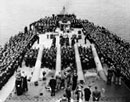 |
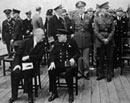 |
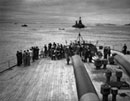 |
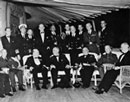 |
14 August 1941
Atlantic Conference, aboard the British battleship HMS Prince of Wales, "somewhere at sea"
[Read more]
|
14 August 1941
Atlantic Conference, aboard the British battleship HMS Prince of Wales, "somewhere at sea"
[Read more] |
14 August 1941
Atlantic Conference, aboard the British battleship HMS Prince of Wales, "somewhere at sea"
[Read more] |
14 August 1941
Atlantic Conference, aboard the US heavy cruiser USS Augusta. [Read more] |
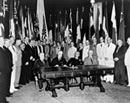 |
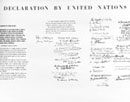 |
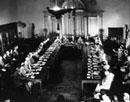 |
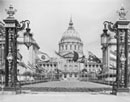 |
1 January 1942
First Washington Conference, Washington DC
[Read more]
|
1 January 1942
The Declaration by United Nations, Washington DC
[Read more] |
21 August 1944
Conference on Security Organization for Peace in the Post-War World at Dumbarton Oaks Estate,
Washington DC
[Read more]
|
25 April-26 June 1945
San Francisco Conference: flags of the United Nations flying in the courtyard of San Francisco City Hall.
[Read more] |
 |
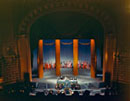 |
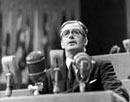 |
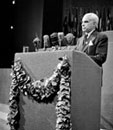 |
25 April-26 June 1945
The San Francisco Conference, Auditorium of the Opera House.
[Read more]
|
25 April-26 June 1945
The San Francisco Conference, Auditorium of the Opera House.
[Read more] |
26 April 1945
San Francisco Conference, First Plenary Session
[Read more] |
30 April 1945
San Francisco Conference, Fifth Plenary Session
[Read more] |
 |
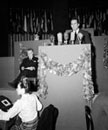 |
 |
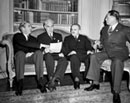 |
30 April 1945
San Francisco Conference, Fifth Plenary Session
[Read more] |
2 May 1945
San Francisco Conference
[Read more] |
25 April-26 June 1945
San Francisco Conference
[Read more] |
25 April-26 June 1945
San Francisco Conference, informal meeting at Mr. Stettinius’ apartment in the Fairmont Hotel, San Francisco
[Read more]
|
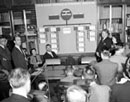 |
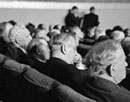 |
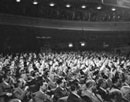 |
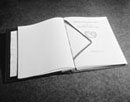 |
25 April-26 June 1945
San Francisco Conference, Secretariat offices
[Read more]
|
25 April-26 June 1945
San Francisco Conference: delegates attending a meeting. [Read more] |
25 April-26 June 1945
San Francisco Conference, Auditorium of the Opera House.
[Read more]
|
25 April-26 June 1945
San Francisco Conference: the United Nations Charter.
[Read more] |
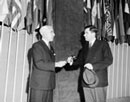 |
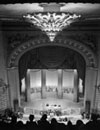 |
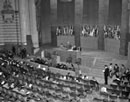 |
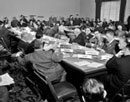 |
25 April-26 June 1945
San Francisco Conference, last public session
[Read more] |
30 May 1945
San Francisco Conference, meeting of Commission II, Auditorium of the Opera House
[Read more] |
25 April-26 June 1945
San Francisco Conference, meeting of Commission II, Auditorium of the Opera House.
[Read more] |
25 April–26 June 1945
San Francisco Conference, meeting of Commission III (Security Council), Committee 2 (Peaceful Settlement).
[Read more]
|
 |
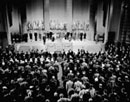 |
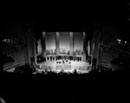 |
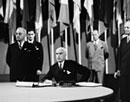 |
25 June 1945
San Francisco Conference
[Read more]
|
26 June 1945
San Francisco Conference
[Read more] |
26 June 1945
San Francisco Conference, sixteenth Plenary Session.
[Read more]
|
26 June 1945
San Francisco Conference
[Read more] |
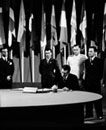 |
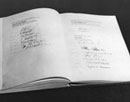 |
 |
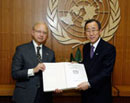 |
26 June 1945
San Francisco Conference
[Read more] |
26 June 1945
The United Nations Charter open to the signatory page.
[Read more] |
1 January 1955
Preamble to the Charter of the United Nation
[Read more] |
2 January 2008
Office of the Secretary-General, United Nations Headquarters,
New York
[Read more] |
|



















































